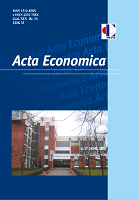EXTERNAL ADJUSTMENT AND FLEXIBILITY OF THE EXCHANGE RATE REGIME: THE CASE OF TRANSITION COUNTRIES
EXTERNAL ADJUSTMENT AND FLEXIBILITY OF THE EXCHANGE RATE REGIME: THE CASE OF TRANSITION COUNTRIES
Author(s): Dragan Gligoric, Borce Trenovski, Kristijan KOZHESKISubject(s): Economic policy, International relations/trade, Economic development
Published by: Економски факултет Универзитета у Бањој Луци
Keywords: exchange rate regime; external adjustment; transition countries; first order autoregression;
Summary/Abstract: Milton Friedman’s traditional claim is that flexible exchange rates facilitate external adjustment by means of their corrective movements before the balance of payments crisis occurs. In order to test this hypothesis, we employ the first order autoregression based on the panel data on exchange rate regime and external balance expressed as the share of balance of goods and services in GDP. The sample covers 16 Central and Eastern European (CEE) and 12 Commonwealth of Independent States (CIS) transition countries over the period 2000-2019. The results, which are based on the sample of all transition countries, failed to prove that more flexible exchange rate regimes facilitate external adjustment. When the analysis was performed on two groups of countries separately, the results showed that the deficit of balance of goods and services in CIS countries has a higher persistence compared to CEE countries. However, a more flexible exchange rate regime does not facilitate external adjustment. On the other hand, in CEE countries, the relationship between exchange rate regime flexibility and the rate of balance of goods and services reversion exists, proving that Friedman’s hypothesis does hold.
Journal: Acta Economica
- Issue Year: 19/2021
- Issue No: 34
- Page Range: 9-24
- Page Count: 16
- Language: English

